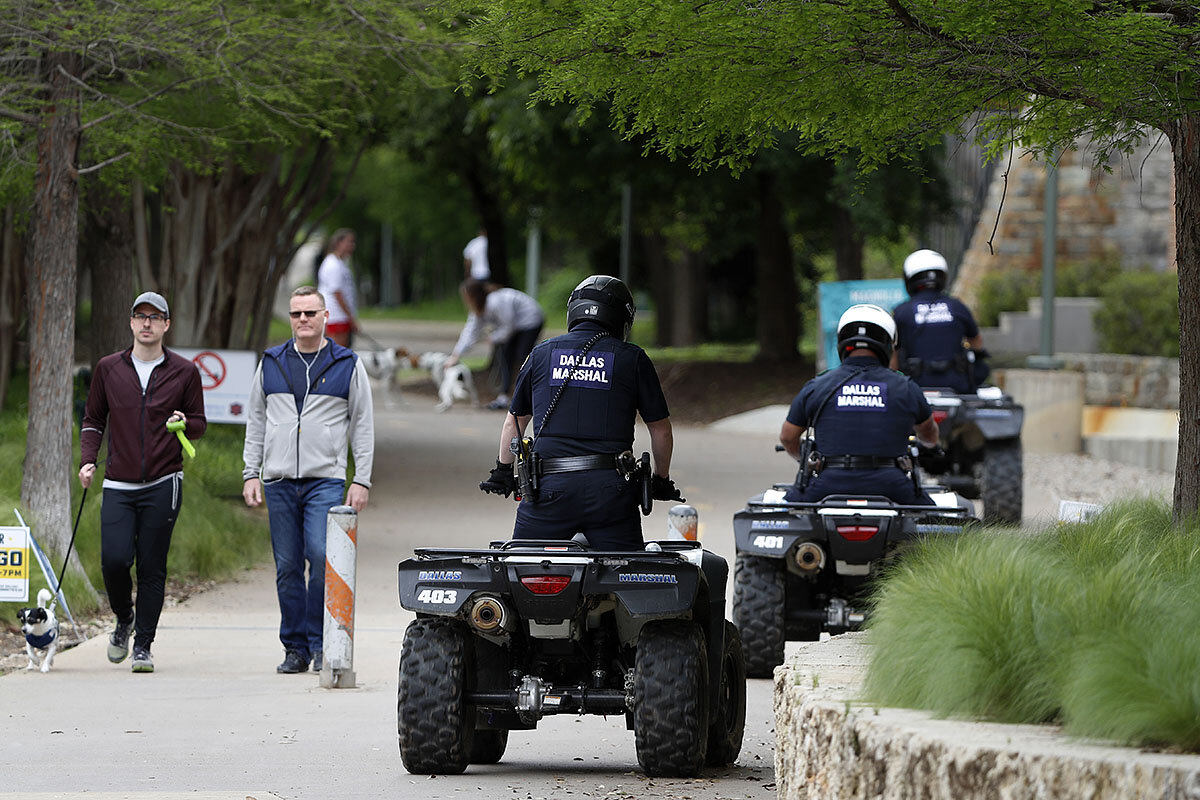Coronavirus conundrum: What do we do when nature gets crowded?
Loading...
| Austin, Texas
Michael Gately and his girlfriend used to go on walks a couple of times a week. Since they’ve been required to stay home because of the coronavirus pandemic, they’ve been going almost every day.
“It’s unquestionably the bright spot of my day,” he says. Although, he adds, “there’s not much else you can do right now.”
On a sunny Monday afternoon, he’s joined dozens of people who have spilled out of their homes onto the Ann and Roy Butler Hike-and-Bike Trail, a popular 10-mile loop around Lady Bird Lake in the heart of Austin. The trail, like public parks around the city, has stayed open even as the rest of the city has locked down.
Why We Wrote This
Coronavirus lockdowns have made nature even more of a refuge. So as officials consider how to adjust rules for now-crowded parks, the public’s mental well-being is a big part of the equation.
How long that will be the case, Mr. Gately doesn’t know. But judging by the crowds, and the narrowness of the trail at points, he says he’d understand if it is closed.
“Health officials have a real dilemma on their hands,” he says. “They want us out here, but at what cost?”
Editor’s note: As a public service, all our coronavirus coverage is free. No paywall.
Austin is one of hundreds of cities across the country navigating this dilemma. With people confined to their homes, outdoor activity has become crucial to maintaining physical and mental health – and it’s also one of the only activities people can do outside their homes.
Around the world, those self-isolating have been surging into parks and onto trails. Yet in the age of social distancing, can crowded public spaces, even green ones, comply? Could closing them provoke a backlash that’s even more dangerous for public health? The issue has been a vexing one, and responses have varied.
In Britain, park closures have been threatened, but for the most part not implemented. In most Texas cities, parks have stayed open. In Los Angeles, city parks and beaches have closed. In New Jersey, all county and many city parks are closed. While in New York City – a COVID-19 hot spot right next door – Central Park has remained open.
The arguments to keep them open are compelling.
“No drug or supplements are as good as [physical] activity in helping the immune system do its job better,” says David Nieman, director of the Human Performance Laboratory at Appalachian State University in Kannapolis, North Carolina. He argues that public green spaces should be closed only as a last resort.
“I put everything on a benefit-risk continuum,” he adds. “There are risks, yes, but if everyone follows the guidelines, I think the benefits outweigh the risks.”
The Quigleys may hike now
For parks that have remained open, a variety of rules have come in to keep users safe.
In New York City, Central Park’s leafy 843 acres are one of the few places where social distancing can be safely practiced. Staff with the Central Park Conservancy has been cleaning and maintaining benches, landscapes, and water bodies in the park.
In Dallas, use of the Katy Trail is being regulated alphabetically. For example, those with last names beginning with A through L should use the trail on Thursday and Saturday.
And in Austin, new rules include limiting parking spaces and having park rangers remind visitors of social distancing guidelines. Traffic on the Butler trail is now moving clockwise only.
“We assumed it would be closed by the city. It was decided they didn’t want to take that step yet,” says Heidi Anderson, CEO of The Trail Foundation, a nonprofit focused on protecting and improving the trail. “The trail doesn’t accommodate high traffic and allow for 6-feet distancing around the whole loop.”
But usage of the Butler trial increased from 134,000 people in March last year to 146,000 people in March this year. “We hear over and over again people use the trail not just for exercise but because it’s their church,” says Ms. Anderson.
Sand in skate parks
Green spaces have certainly been a blessing for Austin’s Megan Divvern. She’s working at a pharmacy while going to pharmacy school, and spending time outdoors “helps take your mind off things.”
She could make do walking around her apartment complex or the surrounding streets if the city decided to close parks. But she doesn’t think there’s too much risk keeping them open.
“I think that’s on people, on individuals, to keep their distance,” she says.
Cities have at times had to crack down. Parks and trails were closed in Asheville, North Carolina, last month after large groups were gathering in parking lots. And in Los Angeles, the city dumped sand in a shuttered skate park where locals kept gathering.
“If people can’t keep 6 feet apart because it’s so crowded, I agree at that point you just have to close it down,” says Dr. Nieman. “That’s why I encourage people to go at off-hours or [exercise] some other place. I’d encourage people to not [ruin] it for everyone else.”
Mr. Gately hopes it doesn’t come to that. “It’s so beautiful,” he says. “It’s a reminder we can still have positive experiences, even during a time like this.”
Editor’s note: As a public service, all our coronavirus coverage is free. No paywall.







